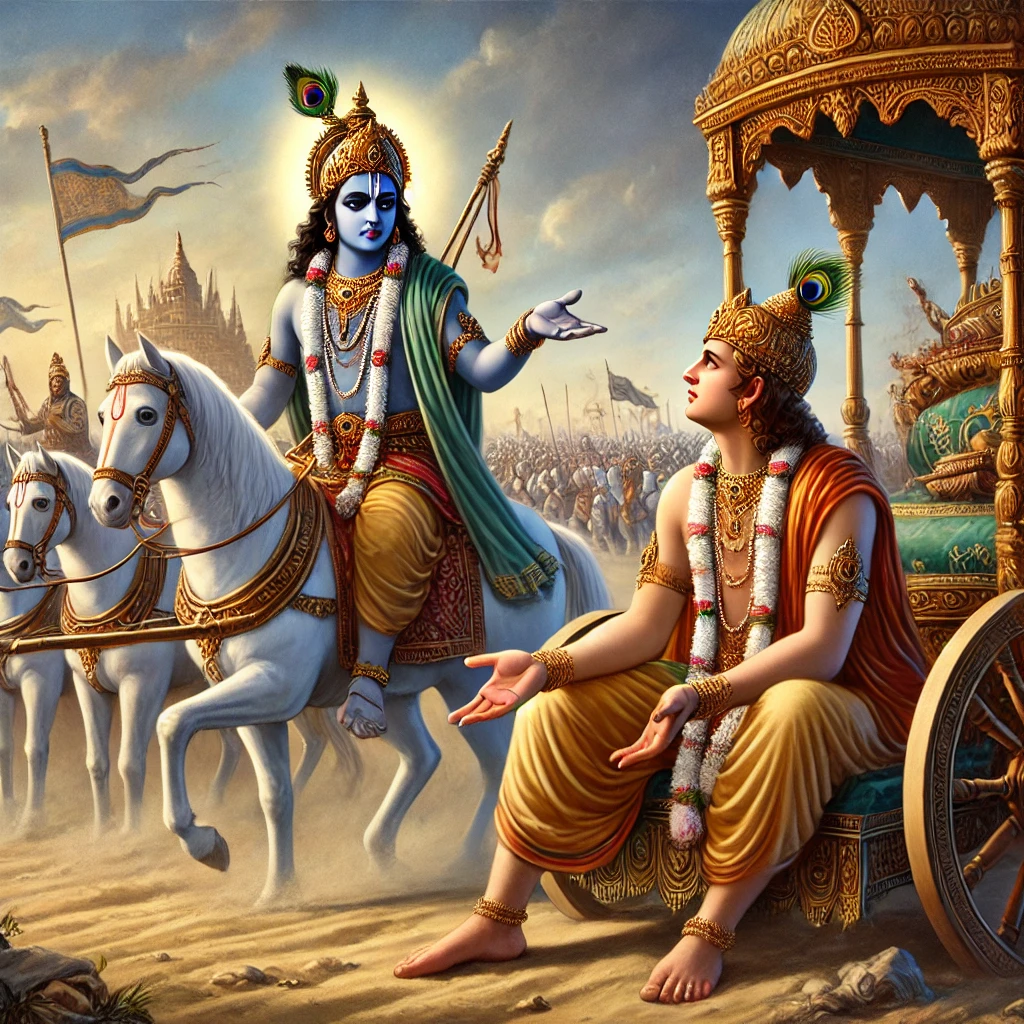The Bhagavad Gita, one of the most revered scriptures in Hinduism, begins with Pratham Adhyaya (Chapter 1), known as Arjuna Vishada Yoga—the Yoga of Arjuna’s Dejection. This chapter sets the stage for the profound philosophical teachings that follow, as it captures the moral and emotional dilemma faced by Arjuna on the battlefield of Kurukshetra.
Overview of the First Chapter
The first chapter of the Bhagavad Gita consists of 47 verses and primarily describes:
- The Battlefield and Participants – The mighty armies of the Pandavas and Kauravas assembled for war.
- Duryodhana’s Strategy – His conversation with Guru Dronacharya, expressing his concerns.
- Arjuna’s Moral Crisis – He becomes overwhelmed with emotions and refuses to fight.
- Krishna’s Presence – Setting the stage for divine guidance.
Key Themes of the First Chapter
1. The Battlefield of Kurukshetra
The Bhagavad Gita begins with Dhritarashtra’s question to Sanjaya:
“What did my sons and the sons of Pandu do after assembling on the battlefield?”
Sanjaya, who was granted divine vision by the sage Vyasa, describes the grand battlefield. He explains how both armies, led by powerful warriors like Bhishma, Drona, Karna, and Arjuna, are ready for war.
2. Duryodhana’s Insecurity and Strategy
Duryodhana approaches Dronacharya and expresses concern about the Pandava army’s strength. Though he appears confident, his words reveal hidden insecurity. He reminds Drona about the great warriors on both sides and urges his army to fight with full force.
3. Arjuna’s Moral Dilemma
As Arjuna looks at the battlefield, he sees his relatives, teachers, and friends on both sides. Overwhelmed by emotion, he is struck by deep sorrow and doubt. He questions:
- “How can I fight against my own family?”
- “What is the point of this war if it leads to the destruction of my loved ones?”
- “Isn’t it better to renounce everything instead of killing my own kin?”
His body trembles, his Gandiva bow slips from his hands, and he refuses to fight.
4. The Beginning of Krishna’s Guidance
Arjuna turns to Lord Krishna, his charioteer and divine friend, for guidance. Though Krishna does not yet respond in this chapter, His presence marks the beginning of a spiritual discourse that will transform Arjuna’s understanding of dharma (duty), karma (action), and bhakti (devotion).
Message of the First Chapter
1. Conflict Between Duty and Emotion
Arjuna’s struggle represents the inner conflicts we all face in life—between our duties and our emotions. Often, we know what is right but hesitate due to fear, attachment, or societal pressure.
2. The Illusion of Attachment
Arjuna’s sorrow stems from his attachment to relationships rather than his duty as a warrior. This highlights the importance of detachment in making righteous decisions.
3. The Need for a Spiritual Guide
Arjuna turns to Krishna, showing that when we are confused, we must seek divine wisdom to navigate life’s dilemmas.
Conclusion: The Transition to Chapter 2
The first chapter ends with Arjuna surrendering to Krishna, setting the stage for the profound teachings that follow. Krishna will soon explain the eternal principles of duty, righteousness, and self-realization, beginning with the wisdom of the immortal soul (Atman) in Chapter 2.
The Bhagavad Gita’s first chapter is a reflection of our own struggles, reminding us that even in the face of great difficulty, divine wisdom can guide us to clarity and purpose.
What do you think about Arjuna’s dilemma? Have you ever faced a similar moral conflict in life? Share your thoughts in the comments!
#BhagavadGita #Spirituality #ArjunaVishadaYoga #HinduPhilosophy #LifeLessons

Leave a Reply